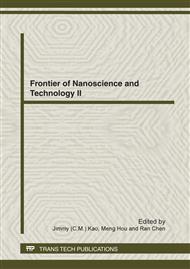p.27
p.31
p.35
p.39
p.43
p.50
p.54
p.58
p.64
Preparation and Hydrogen Storage Kinetics of Nanocrystalline and Amorphous Mg20Ni10-xMx (M=Co, Cu; x=0-4) Alloys
Abstract:
In order to obtain a nanocrystalline and amorphous structure in the Mg2Ni-type alloy, the Ni in Mg2Ni alloy has been partially substituted by M (M=Co, Cu), and the melt spinning has been used to fabricate the Mg20Ni10-xMx (M=Co, Cu; x=0-4) hydrogen storage alloys. The microstructures of the alloys were characterized by XRD, SEM and HRTEM. The effects of substituting Ni with M (M=Co, Cu) on the gaseous and electrochemical hydrogen storage kinetics of the as-spun alloys were investigated. The results indicate that the as-spun (M=Co) alloys display a nanocrystalline and amorphous structure, while the as-spun (M=Cu) alloys hold an entire nanocrystalline structure, suggesting that the substitution of Co for Ni facilitates the glass formation in the Mg2Ni-type alloy. The substitution of M (M=Co, Cu) for Ni exerts a trifling impact on the hydriding kinetics of the alloys, but it renders a marked enhancement of dehydriding capacity and kinetics. Furthermore, the measurements of the high rate discharge ability (HRD) and the hydrogen diffusion coefficient (D) as well as the electrochemical impedance spectra (EIS) of the alloys exhibit that the electrochemical kinetics of the as-spun (30 m/s) alloys is significantly ameliorated by substituting Ni with M (M=Co, Cu).
Info:
Periodical:
Pages:
43-49
Citation:
Online since:
June 2012
Price:
Сopyright:
© 2012 Trans Tech Publications Ltd. All Rights Reserved
Share:
Citation:


